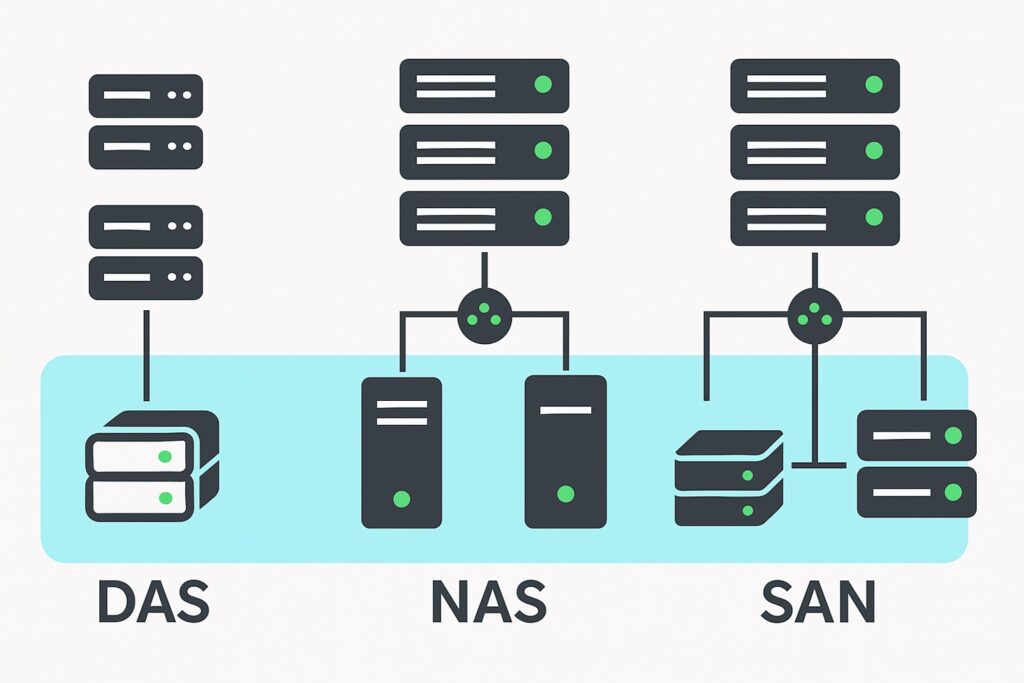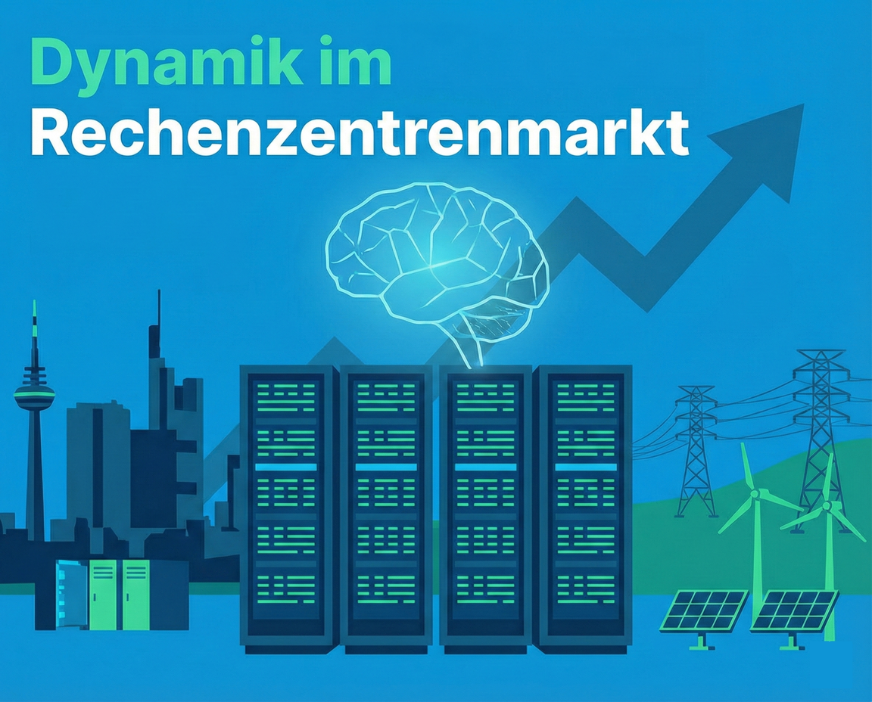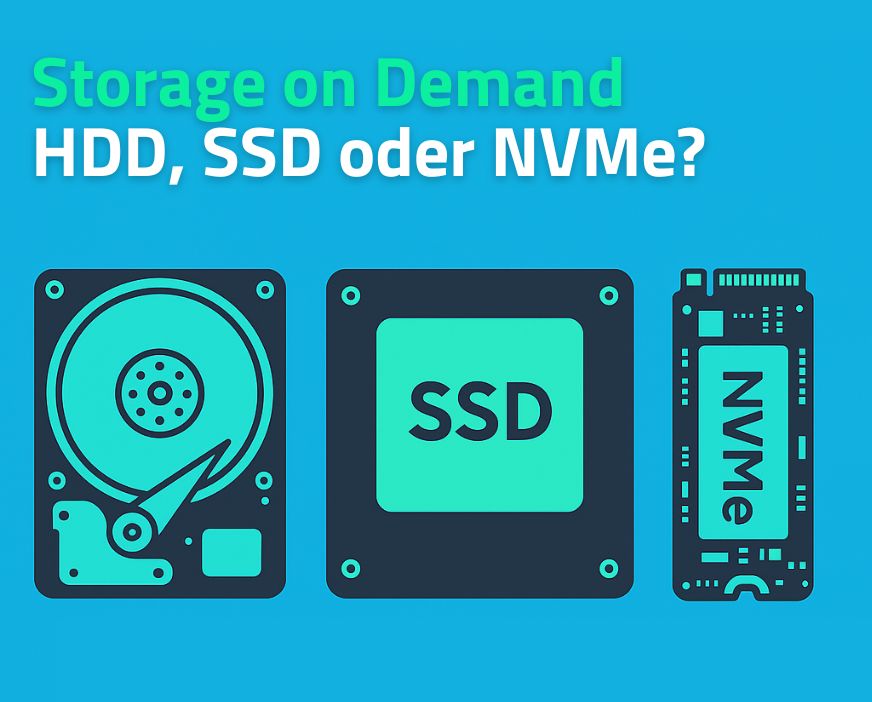The first part of our article series on “Storage on Demand” highlighted the conceptual advantages of flexible storage solutions. In the second part, we turn to the practical level: the physical foundations on which modern storage architectures are based.
Basically, there are three main forms: DAS (Direct Attached Storage), NAS (Network Attached Storage), and SAN (Storage Area Network). They define how storage is physically connected and made available (possibly in the network). They have different characteristics regarding performance, scalability, reliability, and management.
Modern storage solutions seem abstract at first glance: resources can be scaled as needed, storage capacities flexibly assigned, and data dynamically moved. But behind every on-demand model is a physical infrastructure that largely determines how performant, reliable, and expandable a storage solution is. The basis for this are different storage architectures: first and foremost DAS (Direct Attached Storage), NAS (Network Attached Storage), and SAN (Storage Area Network).
These architectures differ in how storage is connected, how many systems can access it simultaneously, and what role network, protocols, and management software play. The choice of the appropriate model strongly depends on the respective application, both technically and economically.
DAS – Locally Connected Storage Without Network Connection
Direct Attached Storage (DAS) refers to storage physically connected directly to a server, for example via SATA, SAS, or PCI-Express. It is exclusively usable locally and not intended for access by other systems on the network. This architecture is simple, cost-efficient, and enables very low latencies, as no network communication is required.
A typical application scenario for DAS is a dedicated database server that only needs to handle local I/O loads. DAS also offers the right solution for certain appliances or monitoring systems that do not need to store their data centrally.
However, the limitations are obvious: Neither high availability nor shared use by multiple systems is easily possible. If the associated server fails, the storage is also no longer accessible. Furthermore, there is a lack of scalability: the available storage space is limited to the drive slots available in the server.

NAS – Network-Based Access to File Systems
Network Attached Storage (NAS) expands on this concept by making storage available over the network for multiple clients. Access is file-based via protocols such as NFS (for Unix/Linux systems) or SMB (for Windows environments). From the clients’ perspective, the storage appears as an additional network drive and can be centrally managed.
Typical use cases are file-based workloads: for example, in a creative agency where multiple employees simultaneously access graphics, presentations, or video files. NAS is also widely used as a central backup target structure or for exchanging large amounts of data in office or development environments. NAS is a cost-effective and popular solution, especially for small and medium-sized businesses, as it can be expanded with many additional functions and has a low monetary entry barrier.
The advantages lie in easy integration, central management, and shared use. At the same time, NAS is technically limited, especially with regard to parallel access, high I/O loads, and performance requirements in virtualized environments. Furthermore, reliability strongly depends on the specific implementation: a single NAS system can represent a Single Point of Failure (SPoF) if no redundancy mechanisms are in place.
SAN – Highly Available Storage Architecture for Professional Workloads
A Storage Area Network (SAN) goes significantly beyond the capabilities of DAS and NAS. In contrast to file-based access with NAS, access with SAN is block-based: at the level of individual data blocks, comparable to local hard drives. This allows for higher performance values and finer control of storage access.
A SAN consists of a dedicated storage network that communicates via Fibre Channel, InfiniBand, or special protocols like iSCSI. It is physically separated from the production network and designed for very high data rates and maximum reliability. In larger data center environments, a SAN is often the central storage platform for virtualized server landscapes, databases, or business-critical applications.
An example: In a virtualized environment, dozens of virtual machines simultaneously access shared data storage. A SAN ensures that these accesses occur in parallel, performantly, and reliably, even under high load. Availability can be secured through redundant controllers, multipathing, and automatic failover.
For instance, CERN, the European Organization for Nuclear Research, operates a Ceph-based SAN cluster architecture with approximately 30 PB of usable storage and continuous read performance of about 30 GB/s to efficiently process the enormous data volumes from LHC experiments.
Another advantage is the flexibility in assigning and managing storage resources: Virtual volumes can be dynamically provisioned, expanded, or migrated without physical intervention. At the same time, operating a SAN requires appropriate infrastructure, expertise, and investments in hardware, network components, and management tools.
Conclusion: Selection of Storage Architecture Based on Needs
DAS, NAS, and SAN form the physical basis of every storage solution, also in the context of “Storage on Demand”. While DAS is suitable for locally limited scenarios (example: operating high-performance databases), NAS offers network-based access to shared files. SAN, in turn, represents a powerful and reliable solution for demanding workloads (such as with CERN’s particle accelerator).
Which architecture is used depends on both the specific application and the requirements for performance, scalability, availability, and management. Modern storage platforms often combine several technologies and abstract them via central software management. This allows even complex storage landscapes to be operated as needed and flexibly.
Do you want to be digitally future-proof and maintain your data sovereignty?
Secure your capacities now
in the AI-Ready data center in Rosbach near FFM.








